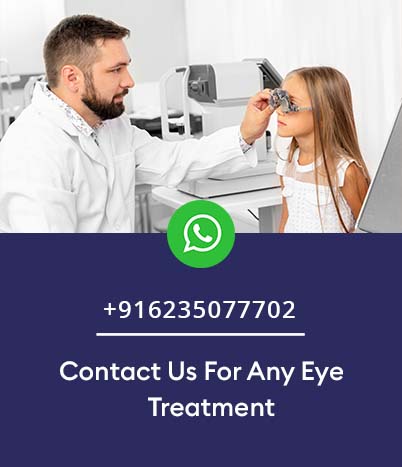

Cataract Care Services
When the lens in your eye becomes cloudy, the light reaching the retina is blurred and distorted and your vision is affected then this clouded lens is called a cataract which must be removed for vision to be restored.
Symptoms
- Blurring vision.
- Sensitivity to light or glare. Glare from lamps or very bright sunlight; or the appearance of a halo around lights
- Double vision in one eye
- Poor night vision
- Needing brighter light to read
- Experiencing fading or yellowing of colours
- If the cloudiness is not near the center of the lens, you may not be aware that you have a cataract
Risk factors
- Agingleads to cataract in most of the people
- Medical conditions: Diabetes , glaucoma, and metabolic abnormalities can cause cataract.
- Trauma : Sudden injuries , Chemical injuries etc can be lead to cataract
How to diagnose a cataract: These may include: A visual acuity test, to find out how clearly the person can see an object. It involves reading a list of letters from across a room.
- A-scan (Invasive ultrasound biometry): he most common use of the A-scan is to determine eye length for calculation of intraocular lens power
- A slit-lamp examination uses a microscope to inspect the cornea, the iris, the lens, and the space between the iris and the cornea
- Tonometry measures the pressure inside the eye
- A retinal examination is carried out after using eye drops to dilate the pupils
In a retinal examination, dilating the pupils provides a larger window to the back of the eyes. The specialist examines the lens for signs of a cataract, and to see how dense any clouding is.
Treatment : During the early stages, stronger glasses and brighter lights may help improve vision The best way to remove cataract is only the surgical removal of cataract lens replacing a artificial iol(Cataractsurgery)
Types of cataract surgeries
Micro Incision Cataract Surgery
Micro incision cataract surgery (MICS) is an approach to cataract surgery through incision less than 1.8 mm with the purpose of reducing surgical invasiveness improving at the same time surgical outcomes.
Advantages : Micro incision cataract surgery (MICS) is an approach to cataract surgery through incision less than 1.8 mm with the purpose of reducing surgical invasiveness improving at the same time surgical outcomes.
Phacoemulsification
Is a modern cataract surgery in which the eye's internal lens is emulsified with an ultrasonic handpiece and aspirated from the eye. Aspirated fluids are replaced with irrigation of balanced salt solution to maintain the anterior chamber.
Advantages:
- Requires a small incision of 3.2 mm
- Stitch less surgery
- Cataract is emulsified and removed using an ultrasonic phacoemulsification probe
- Foldable IOL is implanted
Multifocal IOLs
Are popular as they allow correction of vision for both far & near distance at the same time.
Advantages:
The patient can enjoy the glass free vision even after surgery
Glaucoma
Glaucoma is a condition that causes damage to your eye's optic nerve and gets worse over time. It's often linked to a build up of pressure inside your eye. The first sign is often a loss of peripheral, or side, vision.
Symptoms
- Halos around ligh
- Vision loss
- Redness in the eye
- Eye that looks hazy (particularly in infants)
- Nausea or vomiting
- Eye pain
- Narrowed vision (tunnel vision)
Treatment
Medical treatment
Glaucoma can be treated with certain medication (Eye drops and tablets) so as to lower your eye pressure which should use regularly as directed by your ophthalmologist
Laser treatment
If glaucoma is not controlled with the help of medicines the second option is LASER TREATMENT.
YAG Laser Peripheral Iridotomy
This is an OPD procedure, done under local anesthetic drops and takes only a few minutes to be completed.
Operative procedures
Operation for glaucoma(Trabeculectomy ) is the only option left for patients in whom the eye pressure is not controlled with medication or laser